The Confederate Soldiers Memorial in Hemming Park
Introduction
Text-to-speech Audio
Images
#TakeEmDownJax list of official and public goals
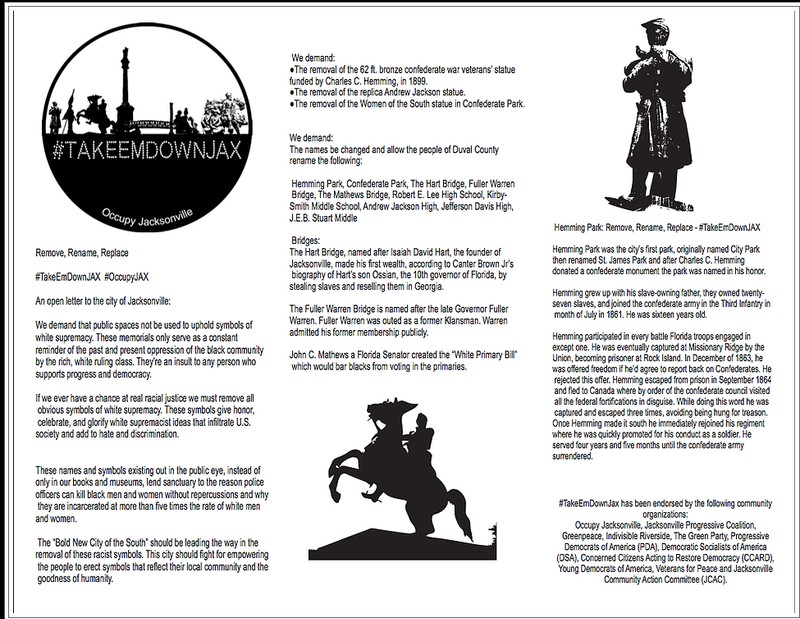
The Confederate Monument in Hemming Park
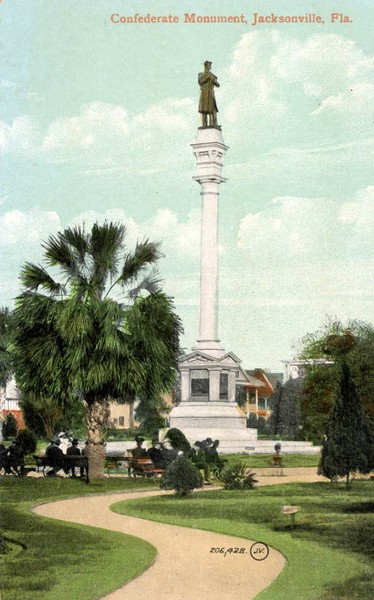
A Black student covered in blood being escorted by a white officer on Axe Handle Saturday




To the Soldiers of Florida:
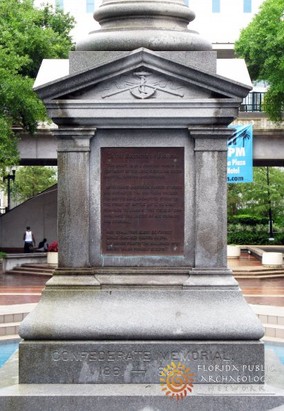

A close up of the confederate soldier
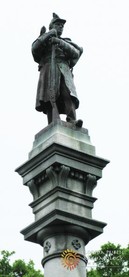
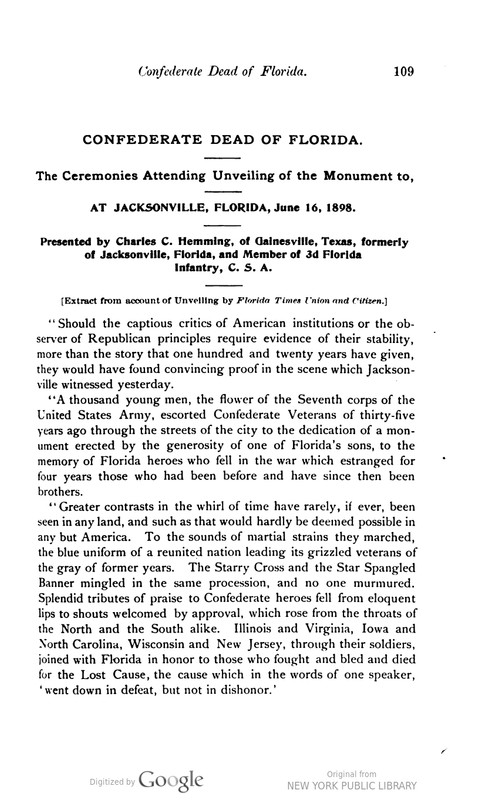
Plaque for the Great Fire of 1901. " On May 3, 1901 at 12:30 p.m., a fire began at the Cleaveland Fibre Factory, ten blocks northwest of this site. Chimney embers ignited sun-dried moss to be used as mattress stuffing. Fueled by wind and dry weather, the fire roared east destroying most structures in its path. By 3:30 p.m., the fire reached this site, then called Hemming Park. The park and its renowned live oaks were devoured by the flames and only the Confederate Monument survived, its base glowing red from heat. The fire continued an eastward march to Hogan's Creek, where a citizens'? bucket brigade stayed the flames. Then, turning south, the inferno roared to Bay Street's riverfront docks. Extreme heat caused a waterspout in the river where rescue boats trolled for survivors. The fire was so intense, Black smoke clouds could be seen as far away as South Carolina. As flames moved west on Bay Street, the firefighters? gallant stand and dying winds brought the fire under control by 8:30 p.m. In just eight hours, nearly 10,000 people were homeless, 2,368 buildings were lost, 146 city blocks were destroyed, but miraculously only seven people perished. Jacksonville's 1901 Fire remains the most destructive burning of a Southern city in U.S. history."
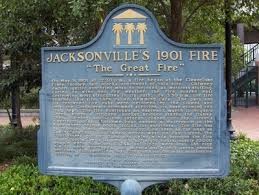
Vandalism of the monument (2017)
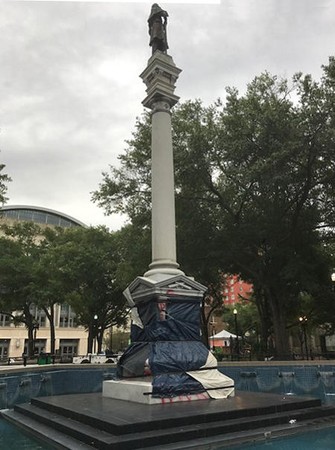
Hemming Park after the Great Fire
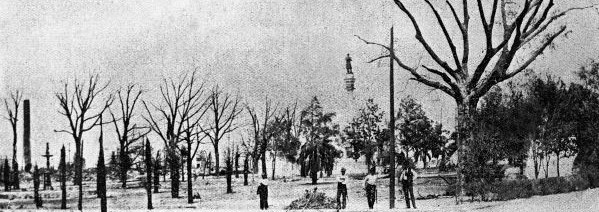
Backstory and Context
Text-to-speech Audio
Hemming had the monument made to memorialize the soldiers and sailors from Florida who served in the Civil war Charles Hemming was a Florida born confederate soldier. After the war, in 1898, he donated this monument to Jacksonville, where he grew up, and had it placed in St James Park in front of City Hall. A year later the park was renamed to honor him, and it is now known as Hemming Park.
“No intelligent and well-informed person of the present day, whose mind is not imbued with fanatical teachings, believes that the Confederates were traitors… No people ever espoused a cause, or went forth to battle in defense of home and country, with a clearer conscience of right in the discharge of duty,” (Brock p114). This was the opening speech at the unveiling ceremony of the monument in 1898. The ceremony was filled with northern and southern soldiers who were stationed in Jacksonville waiting to go fight in the Spanish-American War. The theme of the day was unity between the north and south, and the honor of each. Hemming did not attend, but had a former Confederate Colonel and US Congressman Robert Hamilton McWhorta Davisdson speak on his behalf, “… remember that every monument erected to Confederate soldiers is a reminder of the skill and bravery of the Northern soldiers, who triumphed over courage and heroism unsurpassed ... We are not a divided people ... the Union has been and is forever restored.” There were speeches after speeches, pageants, bands, and singing (Soergel). This day was the embodiment of the Lost Cause, "The war was remembered as primarily a tragedy that led to greater unity and national cohesion, and as a solder’s call to sacrifice in order to save a troubled, but essentially good union, not as the crisis of a nation deeply divided over slavery, race, competing definitions of labor, liberty, political economy, and the future of the West…"(Blight). The deeply embedded ideals of the Lost Cause are the center of the arguments to keep the monument. Those in support feel that the monument represents the unity and bravery of the Florida Soldiers, not a symbol of slavery and oppression.
In 1901 “The Great Fire” destroyed almost all of Jacksonville’s core, leaving the Hemming monument as the lone standing structure (Jacksonville). Hemming Park later installed a plaque to commemorate those lost and highlight the symbolism of the Hemming monument, “...the park and its renowned live oaks were devoured by the flames and only the Confederate Monument survived, its base glowing red from heat…” The fire has become a large factor in the fight to keep the monument; It created another excuse to defend it. Arguers now strongly justify the statue by saying it is a symbol of their town's strength and the historical pillar of their perseverance through adversity.
In 2016, the call to remove the monument became louder. TakeEmDownJax formed a group and movement aimed at removing all confederate monuments from Jacksonville Florida. They wrote an open letter to the city with demands of the many confederate monuments they wanted taken out of public spaces, "These memorials only serve as a constant reminder of the past and present oppression of the Black community by the rich, white ruling class," (TakeEmDownJax). When the city refused to remove it, the monument began being vandalized with red spray paint and the words “KKK” and “Free Slaves”. Rallies and marches were held in the park in protest of the monuments accompanied with the Jacksonville Peace Keepers During this time, a group of volunteers created the Community Remembrance Project aimed at recognizing the real history of Jacksonville. They proposed a plan to install a memorial alongside the sixty-foot monument. The new installation would be a pillar bearing the names of the seven documented lynching victims in Duval County. The plan was proposed by the former City Council President Anna Lopez Brosche. The council voted 14 to 0 to withdrawal the plan without so much as a discussion. They did so with the justification that they would not address bills from members who would be leaving office the next month, which Brosche was. "[Brosche] said the council’s decision to withdraw the legislation without seeking her input — let alone debating or voting on it — is a sign it lacked enough support to pass. 'It is what it is. It’s unfortunate that this is indicative of how the city of Jacksonville has addressed its racial issues since its inception'" (Hong).
Sources
About Us, Hemming Park. Accessed November 19th 2019. http://hemmingpark.org/about/.
Hong, C. (2017, Sep 06). Confederate monuments in hemming park, springfield defaced with red spray paint. TCA Regional News Retrieved from http://www2.lib.ku.edu/login?url=https://search-proquest-com.www2.lib.ku.edu/docview/1935964884?accountid=14556
David Blight, “A Quarrel Forgotten or a Revolution Remembered: Reunion and Race in the Memory of the Civil War.” In Blight, Beyond the Battlefield: Race, Memory, and the American Civil War. University of Massachusetts Press, 2002. P. 120-152
Brock, R. A. (1899). Southern Historical Society Papers: July, 1877 (classic reprint) [2016-12-30 02:59 UTC] (Vol. 27-28). Retrieved from https://hdl.handle.net/2027/nyp.33433079010215
Cunningham, S. A. (Ed.). (1899, January). Hemming Monument For Florida. Confederate Veteran, VII, 110. Retrieved from https://babel.hathitrust.org/cgi/pt?id=hvd.32044035882273&view=1up&seq=116
Davis, E. (2009, October 20). The Great Jacksonville Fire of 1901. Retrieved October 31, 2019, from https://www.metrojacksonville.com/article/2009-oct-the-great-jacksonville-fire-of-1901.
Hong, C. (2019, June 11). Jacksonville City Council abandons plan for lynching memorial in Hemming Park. Retrieved October 31, 2019, from https://www.jacksonville.com/news/20190611/jacksonville-city-council-abandons-plan-for-lynching-memorial-in-hemming-park.
Pantazi, A. (2018, December 23). Jacksonville on the cusp of becoming minority-majority city. Retrieved October 31, 2019, from https://apnews.com/c1d778916e6a42efad2c1247d806cce6.
Ross, M. (2018, May 15). Organizers Plan Thursday March Against Confederacy Statues From Jacksonville To St. Augustine. Retrieved October 31, 2019, from https://news.wjct.org/post/organizers-plan-thursday-march-against-confederacy-statues-jacksonville-st-augustine.
Soergel, M. (2017, Aug 31). Hemming's confederate monument in 1898: A band, a parade, and soldiers in blue and gray. TCA Regional News Retrieved from http://www2.lib.ku.edu/login?url=https://search-proquest-com.www2.lib.ku.edu/docview/1933751058?accountid=14556
TakeEmDownJax https://www.jacksonvilleprogressivecoalition.org/takeemdownjax
The Jacksonville Historical Society. (2019). The Great Fire of 1901. Retrieved October 31, 2019, from http://www.jaxhistory.org/great-fire-1901/.
https://www.jacksonvilleprogressivecoalition.org/takeemdownjax
https://www.floridamemory.com/items/show/241907
https://myfloridahistory.org/frontiers/article/32
https://www.floridamemory.com/items/show/241907
https://www.floridamemory.com/items/show/241907
https://digitalcommons.unf.edu/historical_architecture_main/3259/
https://www.jaxdailyrecord.com/photo-gallery/mayor-calls-vandalism-of-a-confederate-monument-at-hemming-park-disgusting#photo-7
https://www.floridamemory.com/items/show/241907
